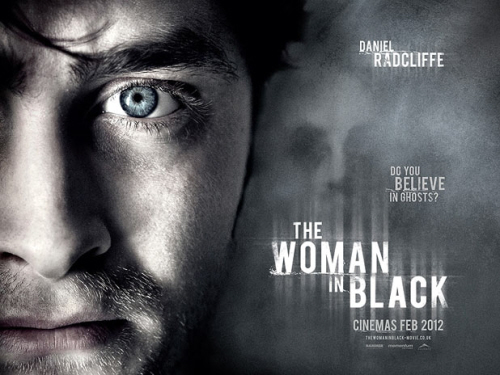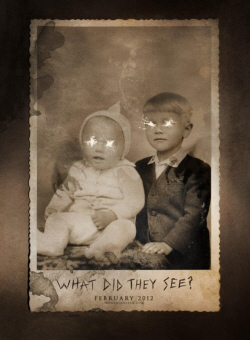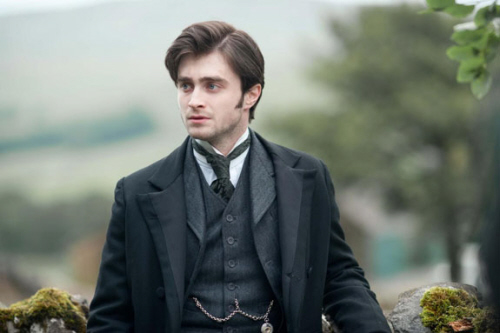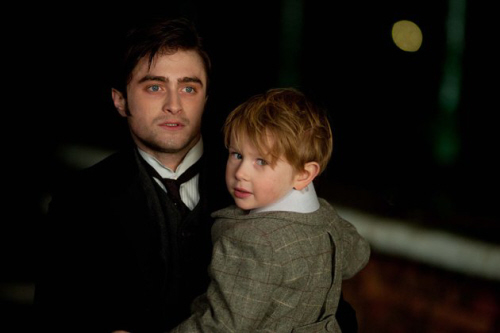
With a short running time, brisk pace and some effective scares, The Woman in Black is the kind of spooky effort that’s good for a few cheap thrills. It also manages to answer some questions about Daniel Radcliffe’s future as a movie star. As a horror release, it’s the tamest kid-killing film I’ve ever seen. And while that may be a unique distinction, I appreciate that Woman seems (mostly) unaffected by the major trends of modern horror as it goes about telling its story.
And a compelling story it is. An adaptation of a 1983 Susan Hill novel, Radcliffe plays Arthur Kipps, a young lawyer (or “solicitor” in the film) sent to the foggy, coastal town Crythin Gifford to sort through the affairs of the recently deceased Alice Drablow. Drablow was an elderly recluse residing in the secluded Eel Marsh House, a house the town’s residents seem fearful of. As Kipps investigates the weirdness of both the house and Drablow, he comes to realize that the ghost of town lore might be compelling children to off themselves in a swiftly disturbing (or fun and fanciful!) ways. I don’t want to spoil it for you, but the answers might have something to do with the title character.
 This is the first release of the revived Hammer Films (an old UK company specializing in horror that was home to the likes of Christopher Lee and Peter Cushing) that genuinely feels like a Hammer film of old. A lot of that has to do with its early 1900s-era English setting, but watching Woman also gives you the sense that director James Watkins (Eden Lake) and screenwriter Jane Goldman (X-men: First Class) were astutely aware of exactly what kind of film they were making. They manage to pack the slow burn and suspense beholden to Hammer in Woman‘s brief 95 minutes.
This is the first release of the revived Hammer Films (an old UK company specializing in horror that was home to the likes of Christopher Lee and Peter Cushing) that genuinely feels like a Hammer film of old. A lot of that has to do with its early 1900s-era English setting, but watching Woman also gives you the sense that director James Watkins (Eden Lake) and screenwriter Jane Goldman (X-men: First Class) were astutely aware of exactly what kind of film they were making. They manage to pack the slow burn and suspense beholden to Hammer in Woman‘s brief 95 minutes.
This film is built almost entirely around the performance of Daniel Radcliffe (Harry Potter, Naked Horse Boy). It’s admittedly jarring at first to accept Radcliffe as a widowed father. But it’s to his credit that he stays the course throughout and walks away a winner here. There’s a 25-minute sequence, the best in the film, with Radcliffe alone in Eel Marsh House. He says nary a word but you’ll still be wrapped up in his reactions, his mannerisms, and his genuine approach to his craft. This is exactly the kind of role that will suit the man in his post-Potter career and he’s absolutely a success.
Woman‘s aura of suspense and creepiness works to great effect. Any time a haunting or kill occurs; Watkins takes his time setting it up and framing it in a context intended to chill. Where the film fails is in its actual mystery and Kipp’s interaction with the residents of Crythin Gifford. Save for one fabulously eerie dinner that Kipp attends at the residence of the wealthy Mr. and Mrs. Daily (played to spectacular effect by Ciarán Hinds and Janet McTeer), Woman‘s build feels rushed. Fleshing out the residents of Gifford would have lent the film a greater bite as kids start getting killed off. As is I get the sense that there were a lot of sequences removed from the final cut. There are a few character beats in the film by townspeople that come off as disingenuous based on what we’ve witnessed up to this point, not to mention a slew of characters we’ve met that disappear wholesale in the third act. It points to the fact that a lot of this film was excised somewhere along the way.

Kipp's time in Crythin Gifford is creepy and atmospheric.
And I wouldn’t call Woman a scary movie. Not by a long shot. There’re the prerequisite jump scares in as well as a few fake outs that are commonplace nowadays. But what makes this film a success is in the mood and atmosphere it conveys. Crythin Gifford is a genuinely creepy place to visit, filled with pale, withdrawn faces that hide the fear behind their eyes. The fog serves to create an otherworldly-ness around the characters, and seperates them from the safety of the outside world. Furthermore, the look of Eel Marsh House is both stunning and macabre – the most threatening aspect in this ominous corner of the world. Thankfully, Watkins does a great job at using CG at a minimum, going practical whenever possible. It’s a drum I continue to beat, but practical effects lend weight and tangibility where CG simply cannot.
I liked The Woman in Black. It’s not the sort of film we’ll be talking about years from now, but it’s a positively serviceable chiller that fits the Hammer pantheon admirably. Jane Goldman’s on something of a hot streak, coming off Kick-ass, X-Men: First Class, The Debt and now this. And James Watkins is a director I would love to see continue tackling horror, as Woman hints at a keen sense of what works in one of my favorite genres.

Kipp catching the next train to London.
Like its promising director, the potential of The Woman in Black is never fully reached here. But enough of the right parts are in the right places to raise the material above middling and turn out something solid. A recommendation, but also a suggestion that it’ll make a greater rental than theatrical experience.